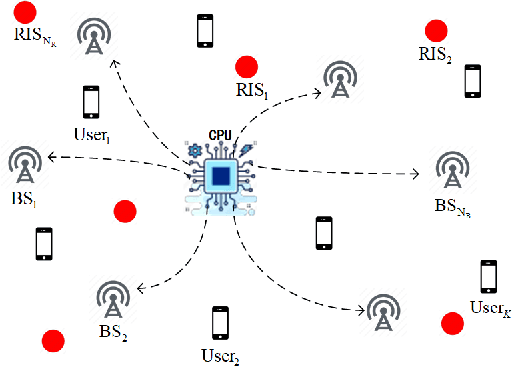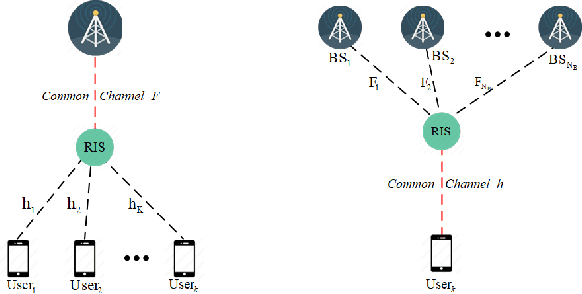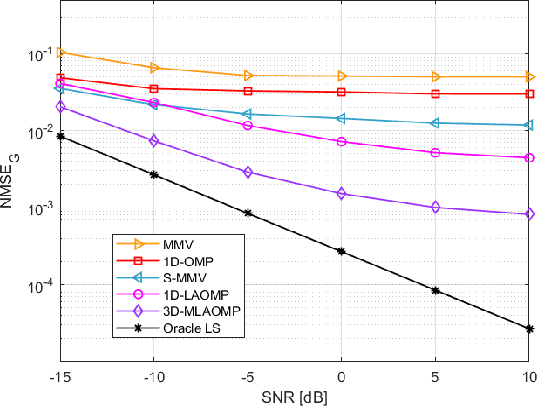Chenfei Xie
Power Source Allocation for RIS-aided Integrating Sensing, Communication, and Power Transfer Systems Based on NOMA
Nov 01, 2024



Abstract:This paper proposes a novel communication system framework based on a reconfigurable intelligent surface (RIS)-aided integrated sensing, communication, and power transmission (ISCPT) communication system. RIS is used to improve transmission efficiency and sensing accuracy. In addition, non-orthogonal multiple access (NOMA) technology is incorporated in RIS-aided ISCPT systems to boost the spectrum utilization efficiency of RIS-aided ISCPT systems. We consider the power minimization problem of the RIS-aided ISCPT-NOMA system. Power minimization is achieved by jointly optimizing the RIS phase shift, decoding order, power splitting (PS) factor, and transmit beamforming while satisfying quality of service (QoS), radar target sensing accuracy, and energy harvesting constraints. Since the objective function and constraints in the optimization problem are non-convex, the problem is an NP-hard problem. To solve the non-convex problem, this paper proposes a block coordinate descent (BCD) algorithm. Specifically, the non-convex problem is divided into four sub-problems: i.e. the transmit beamforming, RIS phase shift, decoding order and PS factor optimization subproblems. We employ semidefinite relaxation (SDR) and successive convex approximation (SCA) techniques to address the transmit beamforming optimization sub-problem. Subsequently, we leverage the alternating direction method of multipliers (ADMM) algorithm to solve the RIS phase shift optimization problem. As for the decoding order optimization, we provide a closed-form expression. For the PS factor optimization problem, the SCA algorithm is proposed. Simulation results illustrate the effectiveness of our proposed algorithm and highlight the balanced performance achieved across sensing, communication, and power transfer.
Near-Field Channel Estimation for Extremely Large-Scale Reconfigurable Intelligent Surface (XL-RIS)-Aided Wideband mmWave Systems
Apr 02, 2023Abstract:Near-field communications present new opportunities over near-field channels, however, the spherical wavefront propagation makes near-field signal processing challenging. In this context, this paper proposes efficient near-field channel estimation methods for wideband MIMO mmWave systems with the aid of extremely large-scale reconfigurable intelligent surfaces (XL-RIS). For the wideband signals reflected by the analog RIS, we characterize their near-field beam squint effect in both angle and distance domains. Based on the mathematical analysis of the near-field beam patterns over all frequencies, a wideband spherical-domain dictionary is constructed by minimizing the coherence of two arbitrary beams. In light of this, we formulate a two-dimensional compressive sensing problem to recover the channel parameter based on the spherical-domain sparsity of mmWave channels. To this end, we present a correlation coefficient-based atom matching method within our proposed multi-frequency parallelizable subspace recovery framework for efficient solutions. Additionally, we propose a two-dimensional oracle estimator as a benchmark and derive its lower bound across all subcarriers. Our findings emphasize the significance of system hyperparameters and the sensing matrix of each subcarrier in determining the accuracy of the estimation. Finally, numerical results show that our proposed method achieves considerable performance compared with the lower bound and has a time complexity linear to the number of RIS elements.
Channel Estimation for Reconfigurable Intelligent Surface-Assisted Cell-Free Communications
Jul 28, 2022



Abstract:Recent research has focused on reconfigurable intelligent surface (RIS)-assisted cell-free systems with the goal of enhancing coverage and lowering the cost of cell-free networks. However, current research makes the assumption that the perfect channel state information is known. Channel acquisition is, certainly, a difficulty in this case. This work is aimed at investigating RIS-assisted cell-free channel estimation. Toward this end, two unique characteristics are pointed out: 1) For all users, a common channel exists between the base station (BS) and the RIS; and 2) For all BSs, a common channel exists between the RIS and the user. Based on these two characteristics, cascaded and two-timescale channel estimation concerns are studied. Subsequently, two solutions for tackling with the two issues are presented respectively: a three-dimensional multiple measurement vector (3D-MMV)-based compressive sensing technique and a multi-BS cooperative pilot-reduced methodology. Finally, simulations illustrate the effectiveness of the schemes we have presented.
Fast Compressive Channel Estimation for MmWave MIMO Hybrid Beamforming Systems
Jul 28, 2022


Abstract:Given the high degree of computational complexity of the channel estimation technique based on the conventional one-dimensional (1-D) compressive sensing (CS) framework employed in the hybrid beamforming architecture, this study proposes two low-complexity channel estimation strategies. One is two-stage CS, which exploits row-group sparsity to estimate angle-of-arrival (AoA) first and uses the conventional 1-D CS method to obtain angle-of-departure (AoD). The other is two-dimensional (2-D) CS, which utilizes a 2-D dictionary to reconstruct the 2-D sparse signal. To conduct a meaningful comparison of the three CS frameworks, i.e., 1-D, two-stage and 2-D CS, the orthogonal match pursuit (OMP) algorithm is employed as the basic algorithm and is expanded to two variants for the proposed frameworks. Analysis and simulations demonstrate that when the 1-D CS method is compared, two-stage CS has somewhat lower performance but significantly lower computational complexity, while 2-D CS is not only the same as 1-D CS in terms of performance but also slightly lower in computational complexity than two-stage CS.
 Add to Chrome
Add to Chrome Add to Firefox
Add to Firefox Add to Edge
Add to Edge